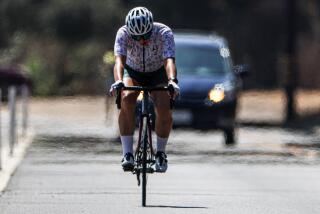‘Cool Centers’ Take the Simmer Out of Summer
- Share via
THERMAL, Calif. — After toiling all day in the pepper fields and sweltering triple-digit temperatures, farmworker Eulalia Solis heads home to a trailer whose overworked swamp cooler provides only a tinge of relief.
She cannot afford an air conditioner, and even if she could, the wiring at the trailer park wouldn’t provide enough power for a window unit.
To cool off, the family gathers on the couch next to the swamp cooler -- a low-budget alternative to a/c -- which is perched in a window and blows air that is saturated with water vapor.
“What else are you going to do but tolerate it?” asked Solis, 30, who has lived in the Sonoran Desert city for two years.
For migrant farmworkers like Solis who live in trailer homes nestled between grapefruit orchards, date farms and vineyards in Riverside County, summer can be unbearable and, in some rare cases, even deadly.
To aid residents who are forced to bear the heat, Riverside and San Bernardino counties this month opened shelters at youth, senior and community centers, providing water and snacks, along with a cool respite.
Lupe Pinedo, 64, had heard about the “cool centers” but said that they never did her any good. She doesn’t drive.
Pinedo has hopped from one trailer park to another during her 40 years in the Coachella Valley and said she was all too familiar with the not-so-cool relief that comes from swamp coolers.
That changed last year, when she moved into an air-conditioned trailer in nearby Mecca. Although she welcomes her refuge from the heat, she now has to deal with another problem: cost.
Pinedo pays nearly $300 for electricity in the summer months, mostly to run the air conditioner. Between that and the $255 rent for her trailer space, she doesn’t have much of her late husband’s monthly $687 pension left for food and other utilities.
She used to pay about $250 a month for rent and utilities while living in a trailer with a swamp cooler.
“That’s how people live out here, just scraping by,” Pinedo said. “That’s why people stay where they are, because they don’t have the money for anything better.”
Those who take the brunt of high temperatures and have inadequate refuge -- especially children and seniors -- are susceptible to heat-related illnesses, public health officials say.
In 2003, the most recent year for which statistics are available, Riverside County recorded one heat-related death and 51 hospitalizations. In San Bernardino County, five people died of heat exposure and 47 were hospitalized.
Eric Frykman, health officer for the San Bernardino County Department of Public Health, said deaths in the county from heat stroke and heat exhaustion happened to a small degree. “Out here, we’re used to the 105-degree temperatures,” he said. “Most people know how to deal with it.”
Nonetheless, when temperatures are expected to reach 105 degrees for at least three consecutive days, the departments of public health call for the activation of their cool centers.
Riverside County operates centers in Beaumont, Blythe, Cathedral City, Coachella, Corona, Desert Hot Springs, Hemet, Jurupa, Palm Springs and Perris.
San Bernardino County residents can find relief in Claremont, Highland, Joshua Tree, Loma Linda, Lucerne Valley, Rancho Mirage, Redlands, Rialto and Yucca Valley.
“They serve as energy conservation as well as saving money on electric bills,” said Alida Plascencia, administrative assistant for Community Action Partnership, which provides utility assistance for low-income households.
Araceli Ramirez, 45, who had never heard of the cool shelters, said her family usually beat the heat on weekends by making the half-hour drive to the Indio Fashion Mall. That was until this month, when the Ramirez family moved to another trailer park -- and a home with air conditioning.
Outside their old trailer, they left a playpen used by her 3-year-old son, sheltered from the sun by a white sheet.
A swamp cooler sat abandoned on a deck.
Like Pinedo, Ramirez fears money will become an issue at her new home.
“Our way of living is going to be better, but paying the bills is going to be more difficult,” said Ramirez, who works in the vineyards along with her husband. “We’re going to have to get second jobs, which means we’re going to spend less time with the kids.”
More to Read
Sign up for Essential California
The most important California stories and recommendations in your inbox every morning.
You may occasionally receive promotional content from the Los Angeles Times.













